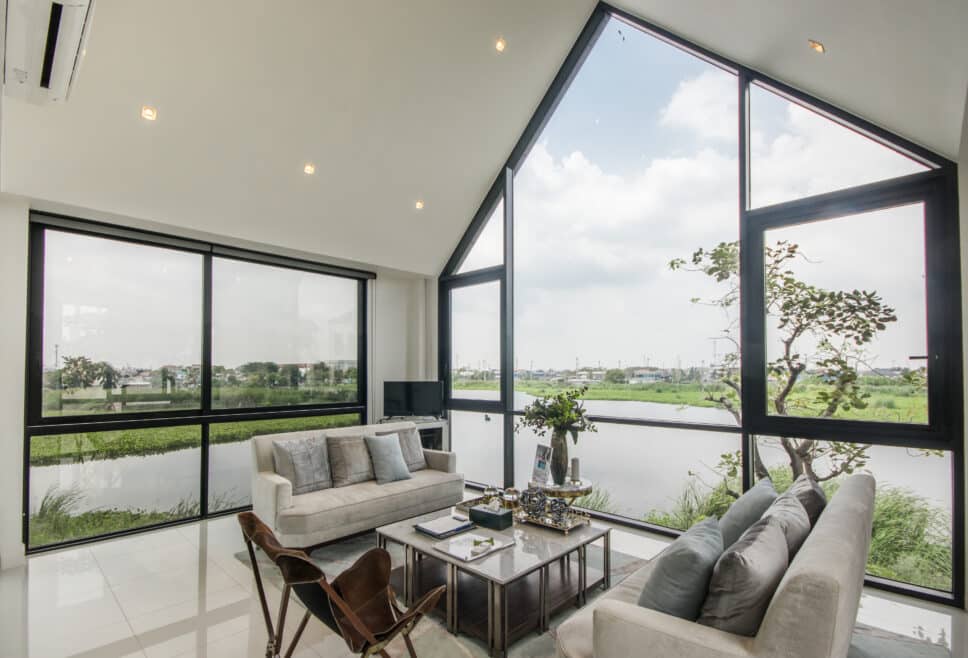For new extensions and property renovations, floor to ceiling windows are unbeatable for filling a room with light, the best possible views and giving a feeling of space. Look at most modern commercial buildings and even the latest trend in home extensions and the floor-to-ceiling aluminium window will be a feature.
The good news is there’s little complication involved with floor to ceiling windows other than the handling of the large glass units. Most sizes can be accommodated with window systems. Other larger sizes may require the more complex curtain walling – the same frame profiles used on high-rise glazing.
Floor to ceiling aluminium windows.
The good news is that virtually all window systems can accommodate a floor to ceiling design. Every aluminium window system will be different but there is no reason why if you’re looking for large aspect windows these cannot be done.
Most systems companies give minimum and maximum sizes for their systems. With a fixed window these will typically be constrained by the maximum glass panel possible. Generally most sizes of large aluminium window should be possible.
Advantages of floor to ceiling windows.

The first obvious advantage of a floor to ceiling window is that they can be a great design feature that allows for maximum light. With large window spaces you can make the most of any views and make a small space instantly feel brighter and larger.
As modern houses are sometimes criticised for their lack of space, designing a large aspect window can help. Look at any modern house and small windows are often a feature. French doors are also quite narrow. Therefore changing a door where possible to a large window will certainly give a more open feel to a room as there are no door mullions and bulky frame and door profiles obstructing the view.
Another consideration is that you may find large fixed glazed windows cheaper than opening casement windows. Assuming there are other windows that can be opened in a room you’ll find that the less profiles, no hardware, less manufacturing time and other factors result in a window that can be quite competitive compared to smaller windows with lots of opening sashes.
Disadvantages of floor to ceiling windows.
It’s important to consider that a floor to ceiling window won’t be disproportionate with the rest of your home and it’s overall design. Having said that a modern extension on the back of a traditional home does work aesthetically and here large windows are ideal.
With any large glazed window comes an issue of privacy. However this consideration would be exactly the same if you’re having bifolding doors or large sliding doors installed. There are various options for shading the window whether you opt for internal fabric or roller blinds or the latest in integral glass blinds.
We mentioned earlier that large windows should work out cheaper than opening windows because they’ll have less aluminium. This is certainly the case when costed correctly and taking the extra pane of glass into consideration.
Depending on the location of your window and particularly if it’s on an upper floor there may be access considerations, glass handling issues and general transportation of the larger glass panels. Most installers will have the capability on their vehicles to carry glass units typically fitted to patio doors. If glass panels are likely to be larger than this there may be an extra cost involved for a cherry picker, a tower or even scaffolding. You may also find additional labour charges as naturally more people may be required to handle the glass and ensure it’s glazed correctly. But none of this should be beyond the skills of an experienced window company.
Solar gain may also be a consideration as the larger glass panels will let in more heat than a smaller window.
Other considerations with floor to ceiling windows.

With such large windows it goes without saying that safety glass is not only a must but also a legal requirement. British Standards and Building Regulations are very clear of the areas where safety glazing is a legal requirement. This includes low level windows, doors and floor to ceiling windows.
Here you have the choice of either toughened safety glass or laminated glass.
In theory, a floor-to-ceiling window can be made as large as the glass pane itself will allow. There are generally few manufacturing designs or installation constraints. If you’re considering these windows and would like further information, please contact us. Our featured image on this post shows the excellent seamless windows from Apeer.










